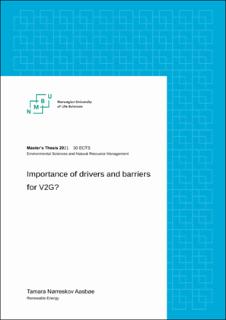| dc.description.abstract | To meet target CO2 emission reductions, there is a shift in power production, where renewable energy sources are replacing conventional power generation based on carbon dense sources like coal, gas, and nuclear. Increasing shares of variable renewable energy (VRE), like wind and solar, which are unpredictable and variable, can be problematic to the electricity grid. To avoid differences in supply and demand, added flexibility and balancing factors are needed. Taking advantage of the growing fleet of electric vehicles (EVs) could be the answer. Vehicle-to-Grid (V2G) technology connects the vehicle to the grid through a bidirectional charger which allows for power flow both ways. Utilizing the EVs battery as energy storage for increased grid flexibility. This technology serves the potential to integrate more of the residual energy provided by VRE back into the power system. For owners of EVs this also presents the opportunity to make revenue, by charging the EV when demand is low and then selling it back to the grid when demand is high. While V2G can contribute to many benefits, as increased grid stability, economic revenue and reduction in CO2 emissions, there are also drivers and barriers that will determine if V2G can be deployed on a large scale. Market-, technological-, economic- and social drivers are crucial for future V2G deployment. One of the most important barriers for V2G is the cost of bidirectional hardware. By estimating the learning curve for the bidirectional charger and the present values of future V2G revenue for different types of consumers, the maximum cost of the charger for each of the consumers is evaluated. Results show that large consumers who pay power tariffs will have more incentives to participate in V2G, and consumers who have larger batteries in their EVs will gain more profit than consumers with smaller EV batteries. | en_US |

